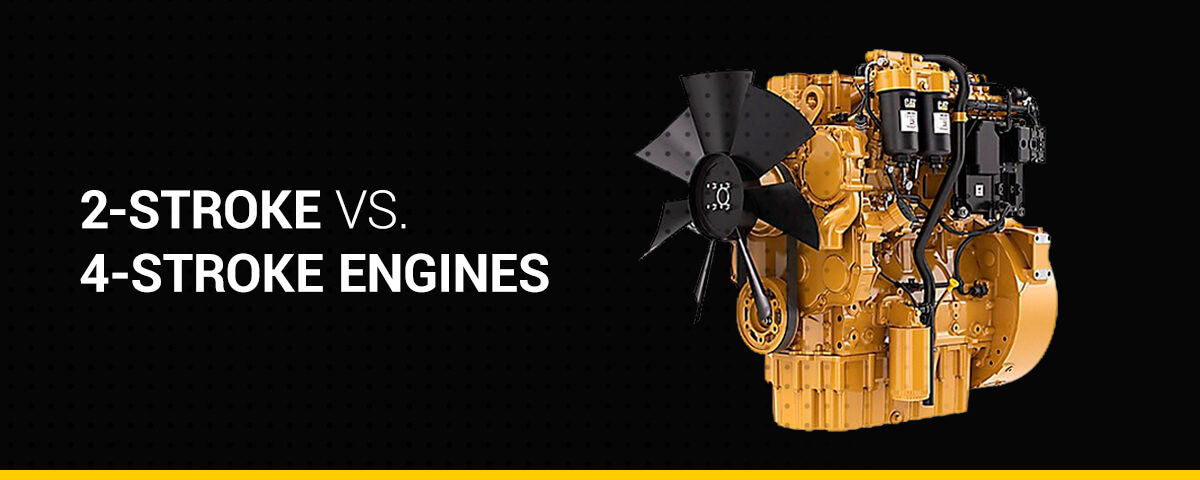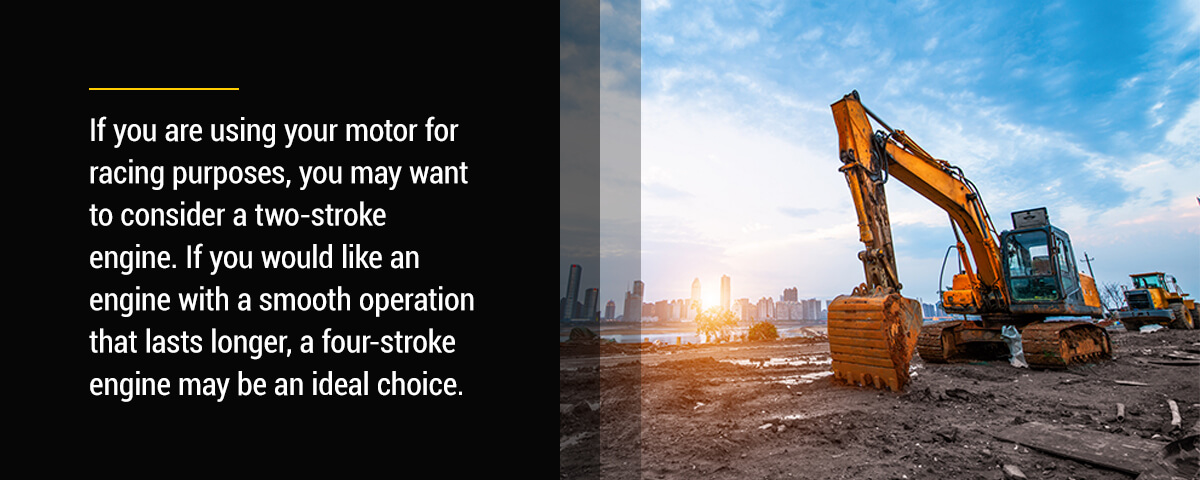
Throughout the many changes and innovations in automotive and engine design, one thing has remained a constant — the design of two-stroke and four-stroke engines. While you may have heard of these types of engines before, you may be asking yourself what the difference is between them. Here’s what you need to know about the efficiency and maintenance of each type of engine.
Jump to Section
- What Is the Difference Between a 2-Stroke and 4-Stroke Engine?
- 2-Stroke vs 4-Stroke Engines
- Pros of a 2-Stroke Engine
- Cons of a 2-Stroke Engine
- Applications of a 2-Stroke Engine
- Pros of a 4-Stroke Engine
- Cons of a 4-Stroke Engine
- Applications of a 4-Stroke Engine
- Which Engine Is Better?
- Choose Prime Source Parts and Equipment for Your Small Engine Needs
What Is the Difference Between a 2-Stroke and 4-Stroke Engine?
The main difference between a 4-stroke engine and a 2-stroke engine is that a 4-stroke engine goes through four stages, or two complete revolutions, to complete one power stroke, while a 2-stroke engine goes through 2 stages, or one complete revolution, to complete one power stroke. This means a 2-stroke engine can potentially produce twice as much power as a 4-stroke engine and also weigh less.
4-Stroke Engine
Four-stroke engines are fuel-efficient and operate in four steps:
- Intake: The intake valve is open, and fuel is drawn in with a downward stroke.
- Compression: As the piston moves upward, the fuel is compressed.
- Power: After the fuel is compressed, it is ignited to produce the engine’s power.
- Exhaust: The exhaust valve opens, and the exhaust gases exit the cylinder.
2-Stroke Engine
A two-stroke engine combines the compression and ignition steps on the upstroke and the power and exhaust steps on the downstroke. This process requires fewer moving parts for easier maintenance, but it does provide less torque.
The two-step process includes:
- Upstroke (ignition/compression): The piston goes up, air and fuel enter the crankcase. The fuel-air mixture is compressed and ignited.
- Downstroke (power/exhaust): Once the fuel is ignited, the piston is pushed down, and the exhaust is expelled.
Both engine types have their pros and cons, and the one that will work best for you depends on the needs of your application.
2-Stroke vs. 4-Stroke Engines
When comparing two- and four-stroke engines, their main difference is in how they operate. Both engines use the combustion cycle to produce energy.
The main difference between a 2- and 4-stroke engine is that a 4-stroke engine goes through four stages, or two complete revolutions, to complete one power stroke. A 2-stroke engine goes through 2 stages, or one complete revolution, to complete one power stroke.
During the combustion cycle in an engine, the piston moves up and down within a cylinder where the piston travels. A stroke is when the piston moves from the top center to the bottom of the cylinder. During a combustion cycle, while the piston moves down the cylinder, it captures air and gas. As the piston moves back up to the top, the exhaust valve opens to expel the exhaust.
Two-stroke engines work by combining more functions into one piston-movement; during the upwards movement of the piston (compressing the air/fuel/oil mixture) in the combustion chamber, underneath the piston a fresh mixture of air/fuel/oil is drawn in the hermetically closed crankcase.
A 4-stroke engine is a very common variation of an internal combustion engine. Pistons go through 4 events, or up and down piston motions, to achieve each power cycle. Upon completion of the 4 events, the cycle is complete and ready to begin again.
While the combustion cycle is relatively similar for both engines, they differ in the number of strokes the piston must move to complete the process. A two-stroke engine completes the five functions of the combustion cycle (intake, compression, ignition, combustion and exhaust) in two piston strokes. A four-stroke engine, on the other hand, completes a combustion cycle after four piston strokes. Another way to think of this process is as one crankshaft revolution for a two-stroke engine and two crankshaft revolutions for a four-stroke version.
Pros of a 2-Stroke Engine
There are many benefits to using a two-stroke engine. Some advantages include:
- A two-stroke engine weighs less compared to a four-stroke engine and requires less space.
- The engine’s turning movement is even since it takes one power stroke for each crankshaft revolution.
- This engine’s design is simple due to the lack of a valve mechanism.
- During operation, this engine creates less friction on parts and has increased mechanical efficiency.
- This engine features a significant power boost with a high power-to-weight ratio.
- The engine can operate at cold and hot external temperatures.
- The engine has inlet and exhaust ports.
Cons of a 2-Stroke Engine
Using a two-stroke engine has some disadvantages such as:
- Two-stroke engines consume more fuel, and only a small amount of fresh charges mix with gasses from the exhaust.
- You may experience a high amount of vibration or noise during operation.
- This engine has a shorter life span since it incurs increased wear and tear.
- A two-stroke engine has a narrow power band, or range of speed where the engine is most efficient.
- This engine type may become unstable while idling.
- You may experience issues with scavenging with this engine.
- A two-stroke engine does not burn as cleanly, leading to a higher level of air pollution than a four-stroke engine.
Applications of a 2-Stroke Engine
Common examples of a two-stroke engine include outdoor power equipment such as chainsaws, blowers, trimmers, hedge trimmers, and various other applications. You can also use a two-stroke engine in transportation and equipment devices such as outboard motors, motorcycles or dirt bikes.
Pros of a 4-Stroke Engine
Using a four-stroke engine offers a variety of benefits. Some of these advantages include:
- Four-stroke engines yield higher levels of torque at a lower RPM during operation.
- A four-stroke engine only consumes fuel once every four strokes, making it a more fuel-efficient engine option.
- Four-stroke engines give off less pollution because they do not require oil or lubricant mixed in the fuel.
- These engines are durable and can withstand higher amounts of wear and tear.
- You will not need additional oil with a four-stroke engine.
- A four-stroke engine produces less noise and vibration during operation.
Cons of a 4-Stroke Engine
Four-stroke engines also have some disadvantages such as:
- The additional components in the four-stroke design make these engines heavier compared to the two-stroke version.
- A four-stroke engine contains more parts and valves, making repairs and maintenance more expensive.
- Since it only receives power once every four rotations of the piston, this design is less powerful than a comparable two-stroke engine.
- This engine design features a gear and chain mechanism, which can cause complications during maintenance.
- A four-stroke engine requires regular maintenance, leading to an increase in costs for products and services.
Applications of a 4-Stroke Engine
Four-stroke engines are a great choice for a variety of uses, such as outdoor power equipment and vehicles. One of the most common examples of equipment powered by a four-stroke engine is a lawnmower. You can also find these engines in a 7cc RC engine to a Cat C18 diesel engine with approximately 800 horsepower.
Which Engine Is Better?
There is no single answer to the question of whether a two-stroke engine or four-stroke engine is better — your selection depends entirely on your personal preferences and applications. While 4-stroke engines perform well and generally last longer than 2-stroke engines, 2-stroke engines are faster and lighter than 4-stroke engines. The 2-stroke engine is more powerful, but a 4-stroke is more fuel-efficient.
Before you select an engine, it’s also essential to understand each type’s lubrication needs. A two-stroke engine requires a mixture of oil and fuel, which ignites when the engine is in operation and continually consumes the oil. Four-stroke engines do not require a mix of oil in the fuel. This makes the four-stroke engine a more fuel-efficient option. The oil in a four-stroke engine flows back to the crankcase after lubricating the different engine parts.
The job of the lubrication system is to distribute oil to the moving parts to reduce friction between surfaces that rub against each other. Friction damages not only moving parts, but the engine’s efficiency as well. Reduced efficiency means horsepower and torque, reduced engine life, increased maintenance costs, and increased emissions.
Ultimately, understanding the difference between two-stroke and four-stroke engines and their needs will help you make the right choice and be proactive in performing maintenance throughout the life span of your engine.
Choose Prime Source Parts and Equipment for Your Small Engine Needs
With the differences between 2-stroke and 4-stroke diesel engines, there is a lot to consider.
At Prime Source Parts and Equipment, we offer product support solutions for owners of two-stroke and four-stroke engines. We have a vast network of suppliers to help our customers find the right parts for all their needs.
Our expert staff of OEM certified and factory-trained technicians can help you find the best product for any project whether you are looking for two-stroke or 4-stroke engine parts or services. For more information or if you have any questions, contact us by calling 704.610.5081 or filling out our contact form today!



